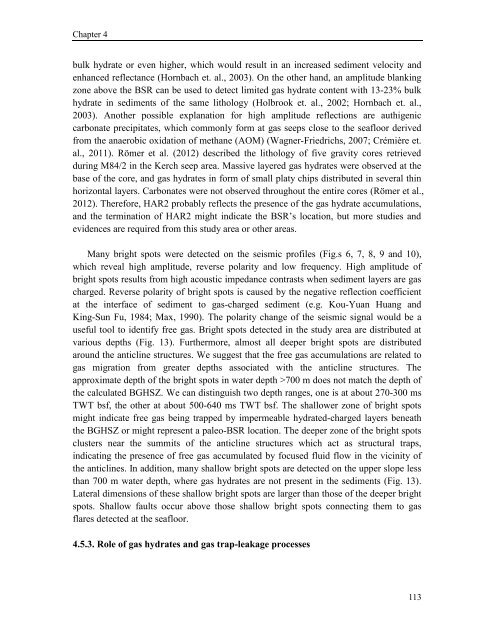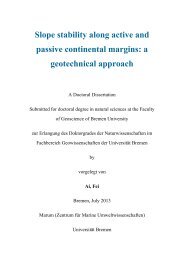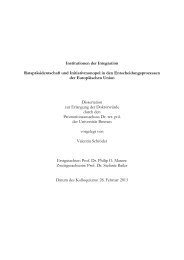Seismoacoustic Study of the Shallow Gas Transport and ... - E-LIB
Seismoacoustic Study of the Shallow Gas Transport and ... - E-LIB
Seismoacoustic Study of the Shallow Gas Transport and ... - E-LIB
Create successful ePaper yourself
Turn your PDF publications into a flip-book with our unique Google optimized e-Paper software.
Chapter 4<br />
bulk hydrate or even higher, which would result in an increased sediment velocity <strong>and</strong><br />
enhanced reflectance (Hornbach et. al., 2003). On <strong>the</strong> o<strong>the</strong>r h<strong>and</strong>, an amplitude blanking<br />
zone above <strong>the</strong> BSR can be used to detect limited gas hydrate content with 13-23% bulk<br />
hydrate in sediments <strong>of</strong> <strong>the</strong> same lithology (Holbrook et. al., 2002; Hornbach et. al.,<br />
2003). Ano<strong>the</strong>r possible explanation for high amplitude reflections are authigenic<br />
carbonate precipitates, which commonly form at gas seeps close to <strong>the</strong> seafloor derived<br />
from <strong>the</strong> anaerobic oxidation <strong>of</strong> methane (AOM) (Wagner-Friedrichs, 2007; Crémière et.<br />
al., 2011). Römer et al. (2012) described <strong>the</strong> lithology <strong>of</strong> five gravity cores retrieved<br />
during M84/2 in <strong>the</strong> Kerch seep area. Massive layered gas hydrates were observed at <strong>the</strong><br />
base <strong>of</strong> <strong>the</strong> core, <strong>and</strong> gas hydrates in form <strong>of</strong> small platy chips distributed in several thin<br />
horizontal layers. Carbonates were not observed throughout <strong>the</strong> entire cores (Römer et al.,<br />
2012). Therefore, HAR2 probably reflects <strong>the</strong> presence <strong>of</strong> <strong>the</strong> gas hydrate accumulations,<br />
<strong>and</strong> <strong>the</strong> termination <strong>of</strong> HAR2 might indicate <strong>the</strong> BSR’s location, but more studies <strong>and</strong><br />
evidences are required from this study area or o<strong>the</strong>r areas.<br />
Many bright spots were detected on <strong>the</strong> seismic pr<strong>of</strong>iles (Fig.s 6, 7, 8, 9 <strong>and</strong> 10),<br />
which reveal high amplitude, reverse polarity <strong>and</strong> low frequency. High amplitude <strong>of</strong><br />
bright spots results from high acoustic impedance contrasts when sediment layers are gas<br />
charged. Reverse polarity <strong>of</strong> bright spots is caused by <strong>the</strong> negative reflection coefficient<br />
at <strong>the</strong> interface <strong>of</strong> sediment to gas-charged sediment (e.g. Kou-Yuan Huang <strong>and</strong><br />
King-Sun Fu, 1984; Max, 1990). The polarity change <strong>of</strong> <strong>the</strong> seismic signal would be a<br />
useful tool to identify free gas. Bright spots detected in <strong>the</strong> study area are distributed at<br />
various depths (Fig. 13). Fur<strong>the</strong>rmore, almost all deeper bright spots are distributed<br />
around <strong>the</strong> anticline structures. We suggest that <strong>the</strong> free gas accumulations are related to<br />
gas migration from greater depths associated with <strong>the</strong> anticline structures. The<br />
approximate depth <strong>of</strong> <strong>the</strong> bright spots in water depth >700 m does not match <strong>the</strong> depth <strong>of</strong><br />
<strong>the</strong> calculated BGHSZ. We can distinguish two depth ranges, one is at about 270-300 ms<br />
TWT bsf, <strong>the</strong> o<strong>the</strong>r at about 500-640 ms TWT bsf. The shallower zone <strong>of</strong> bright spots<br />
might indicate free gas being trapped by impermeable hydrated-charged layers beneath<br />
<strong>the</strong> BGHSZ or might represent a paleo-BSR location. The deeper zone <strong>of</strong> <strong>the</strong> bright spots<br />
clusters near <strong>the</strong> summits <strong>of</strong> <strong>the</strong> anticline structures which act as structural traps,<br />
indicating <strong>the</strong> presence <strong>of</strong> free gas accumulated by focused fluid flow in <strong>the</strong> vicinity <strong>of</strong><br />
<strong>the</strong> anticlines. In addition, many shallow bright spots are detected on <strong>the</strong> upper slope less<br />
than 700 m water depth, where gas hydrates are not present in <strong>the</strong> sediments (Fig. 13).<br />
Lateral dimensions <strong>of</strong> <strong>the</strong>se shallow bright spots are larger than those <strong>of</strong> <strong>the</strong> deeper bright<br />
spots. <strong>Shallow</strong> faults occur above those shallow bright spots connecting <strong>the</strong>m to gas<br />
flares detected at <strong>the</strong> seafloor.<br />
4.5.3. Role <strong>of</strong> gas hydrates <strong>and</strong> gas trap-leakage processes<br />
113
















